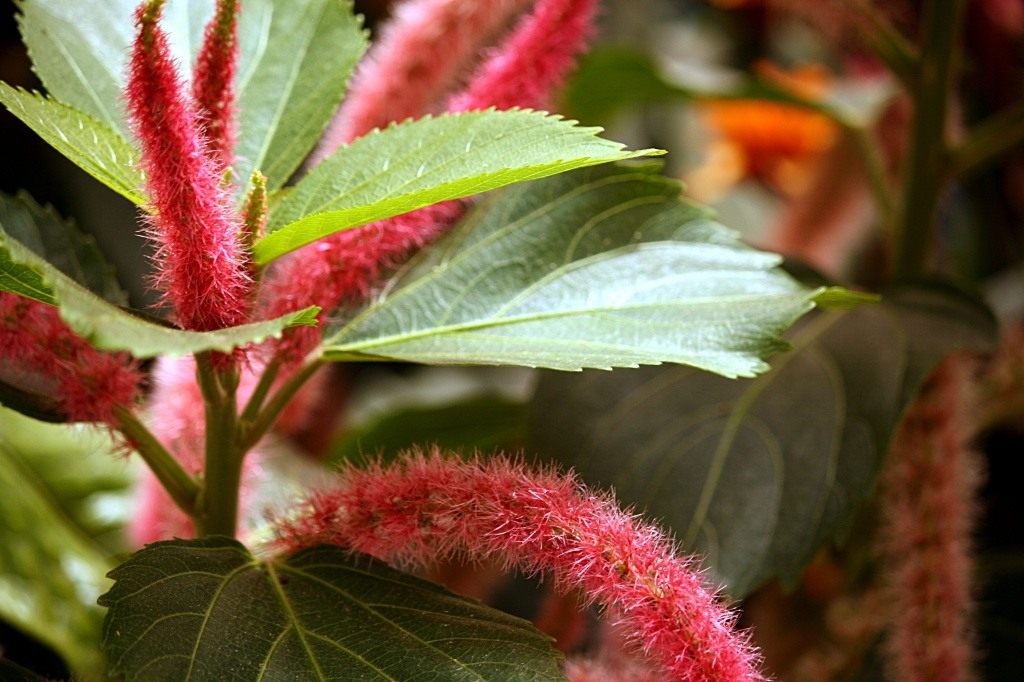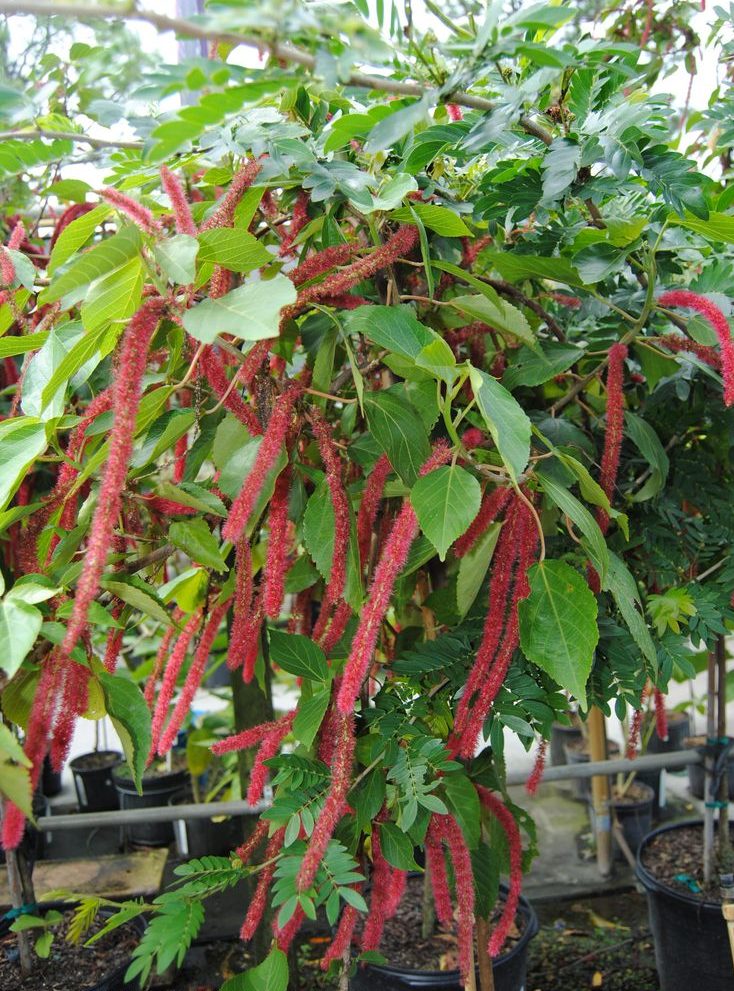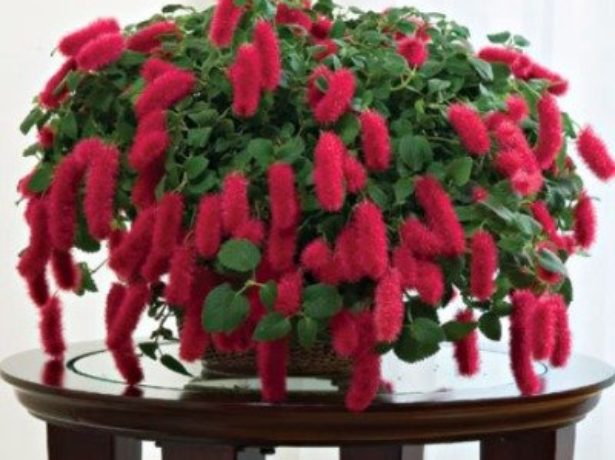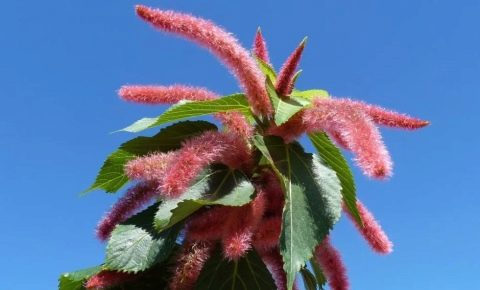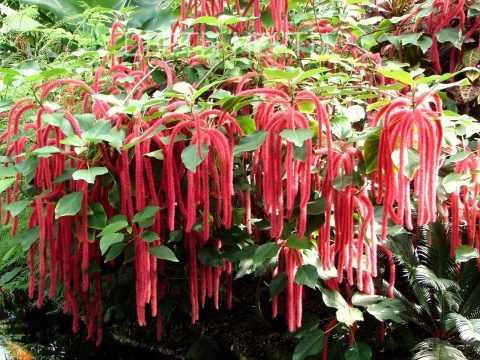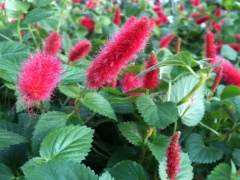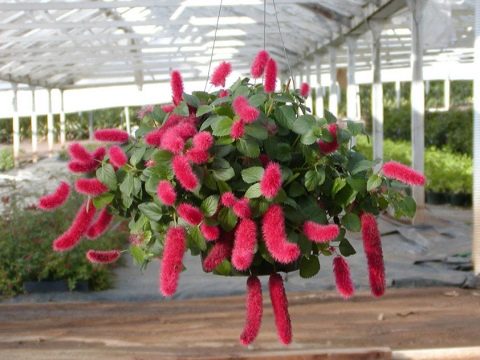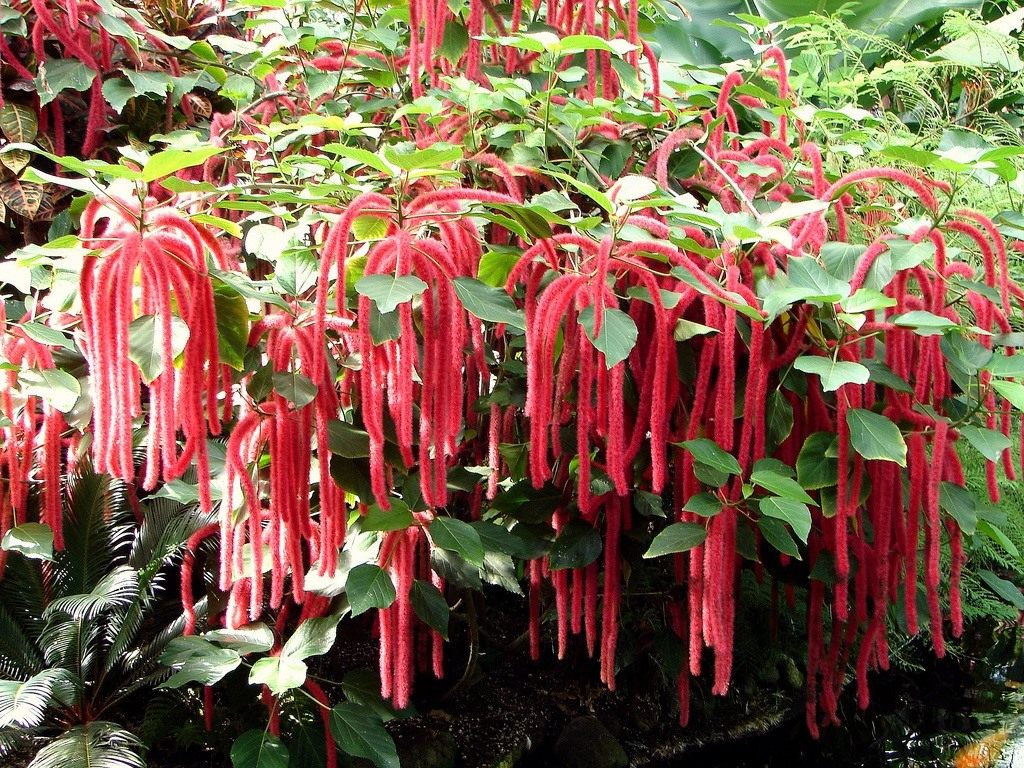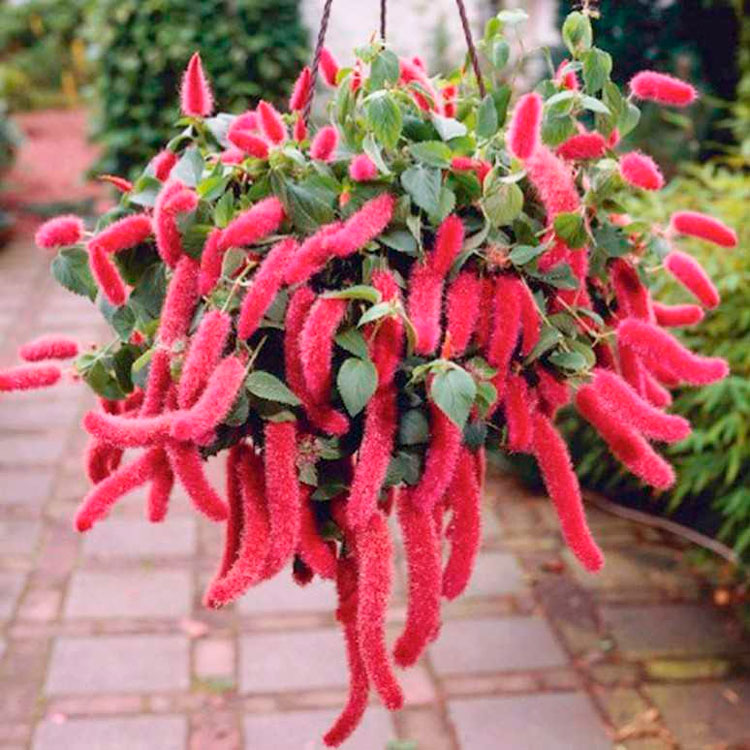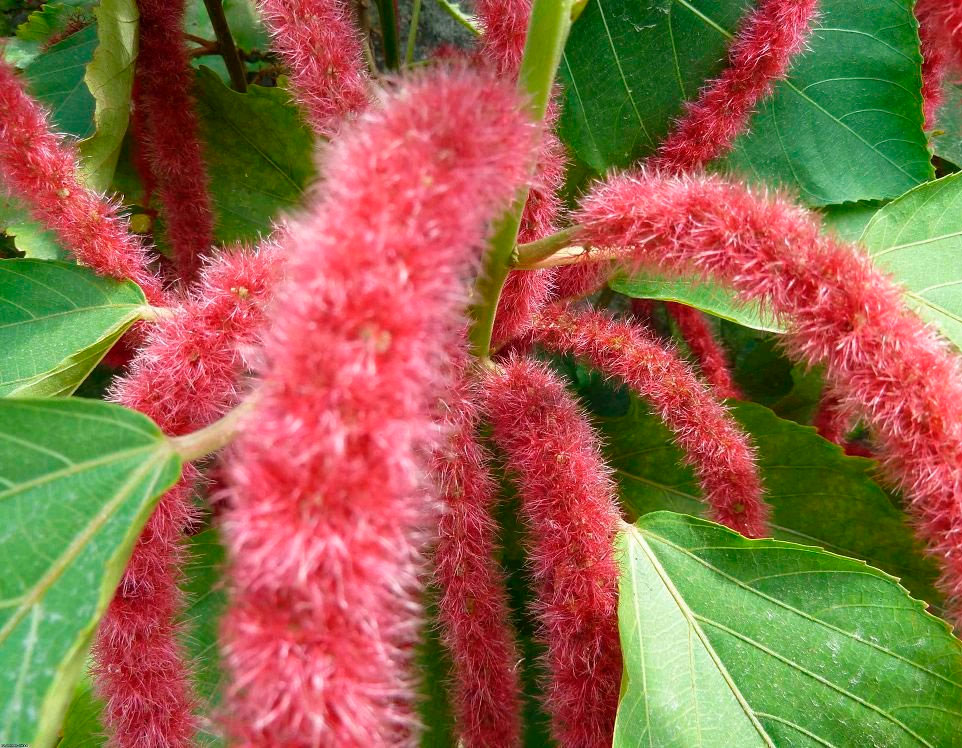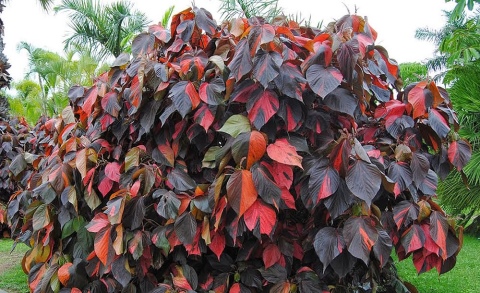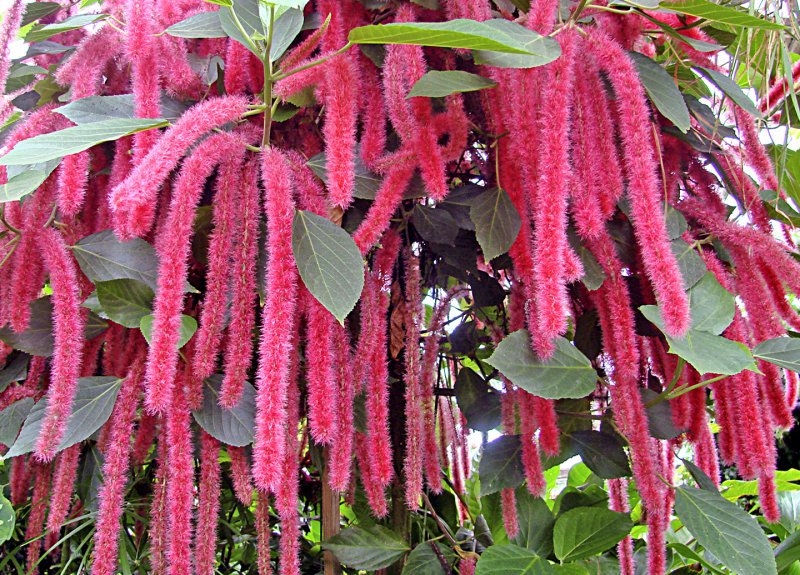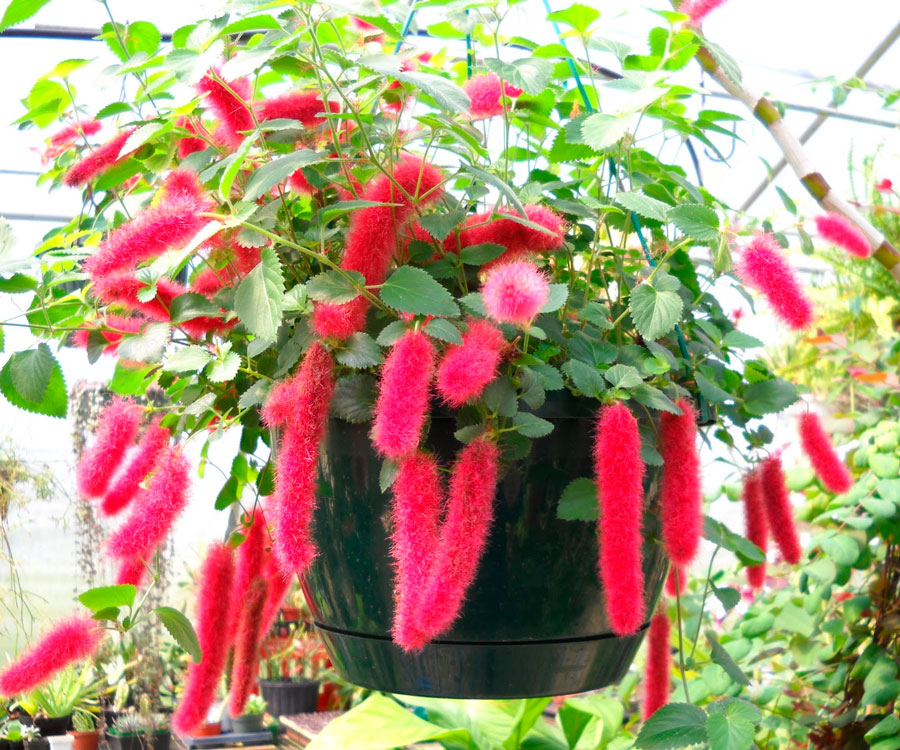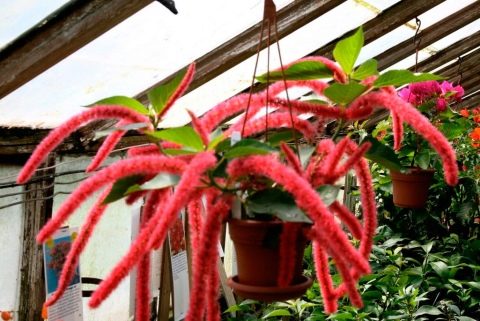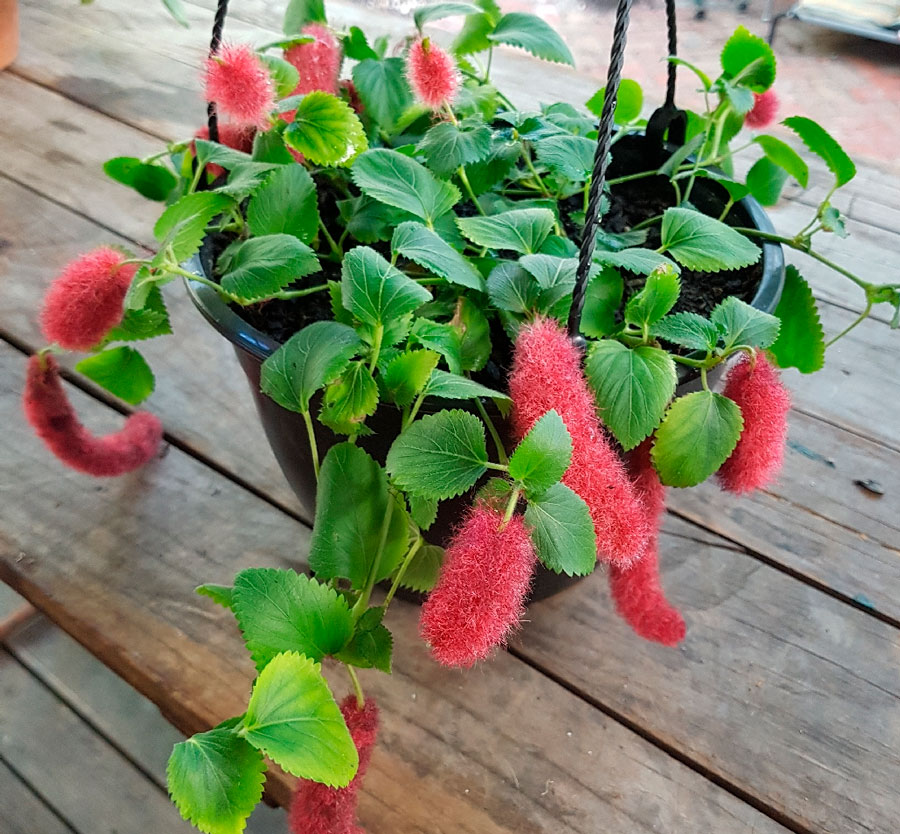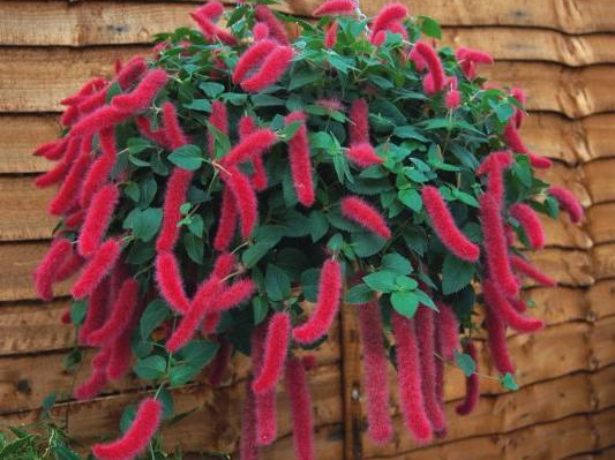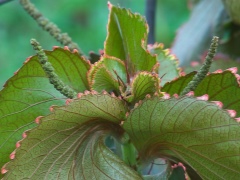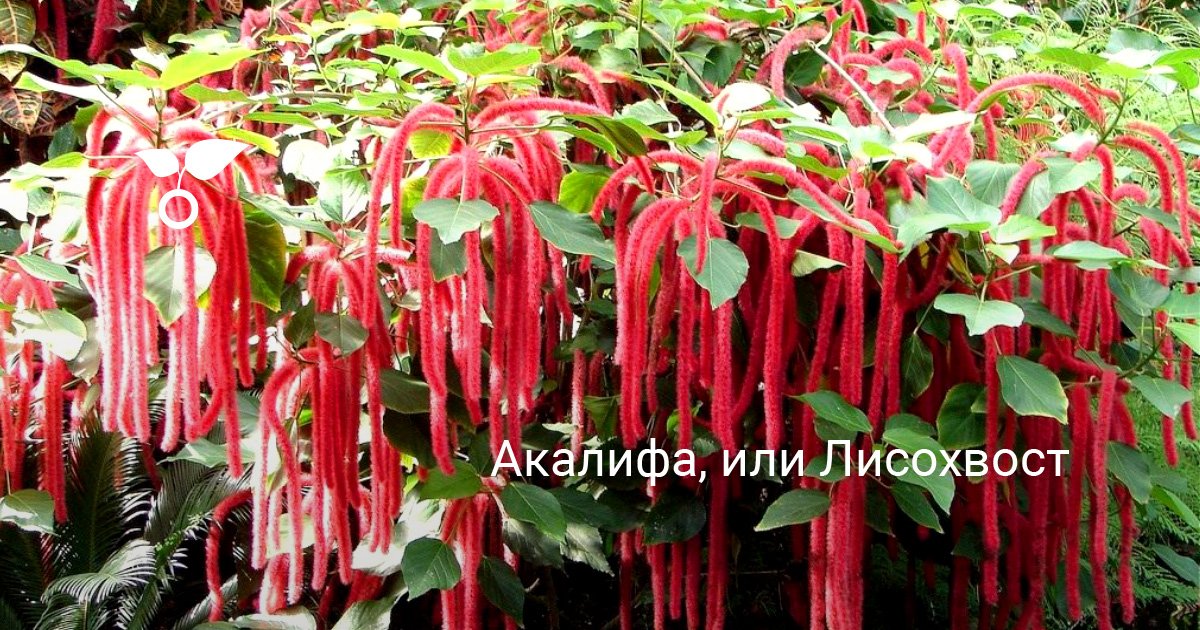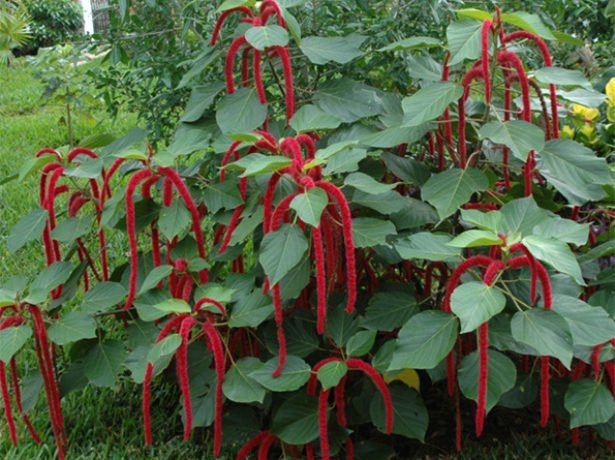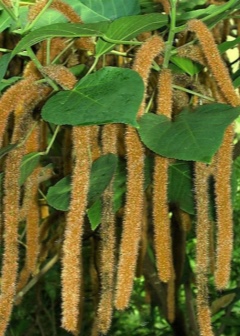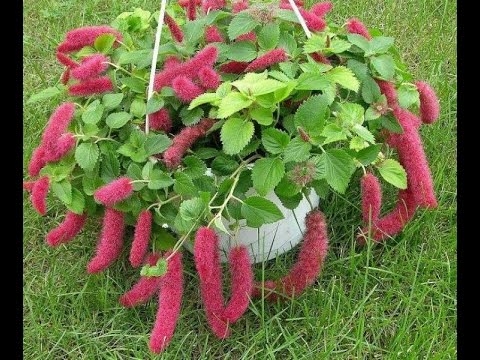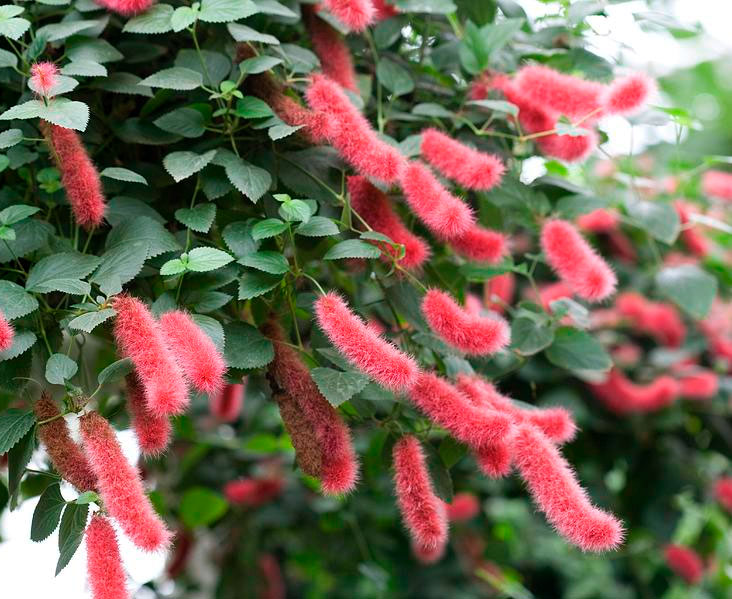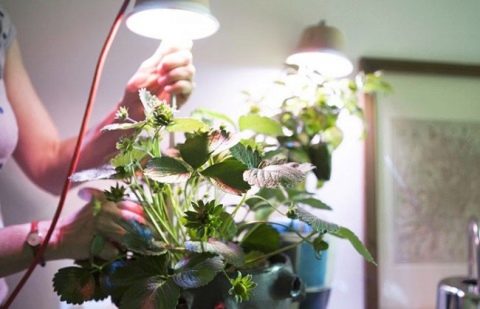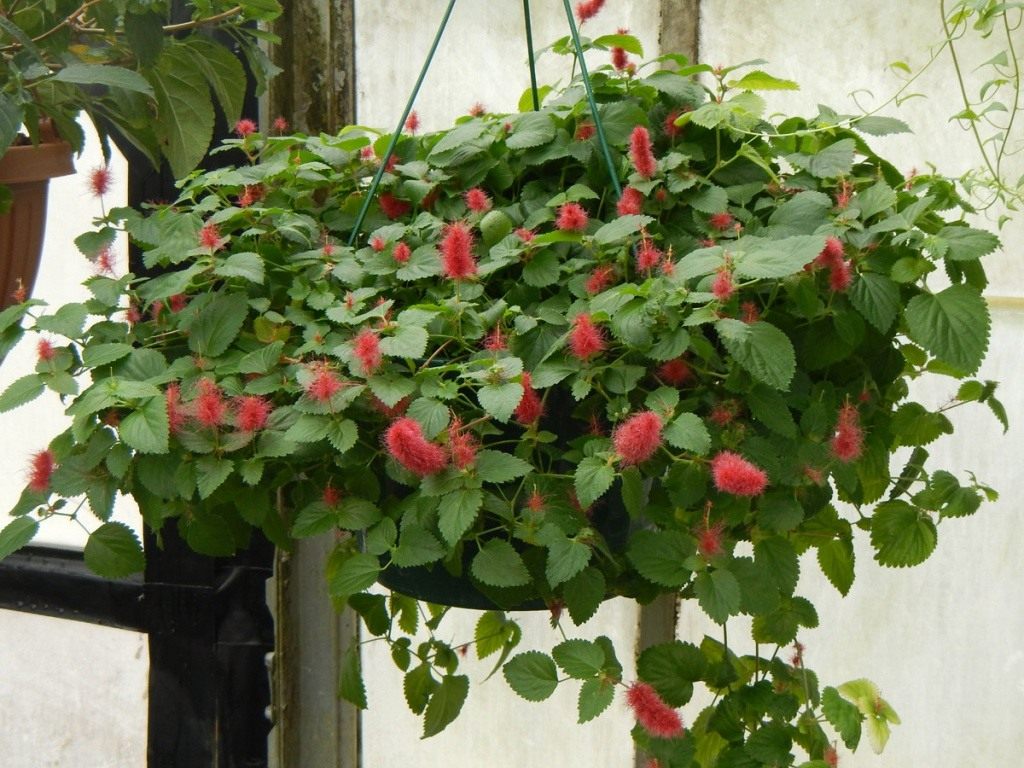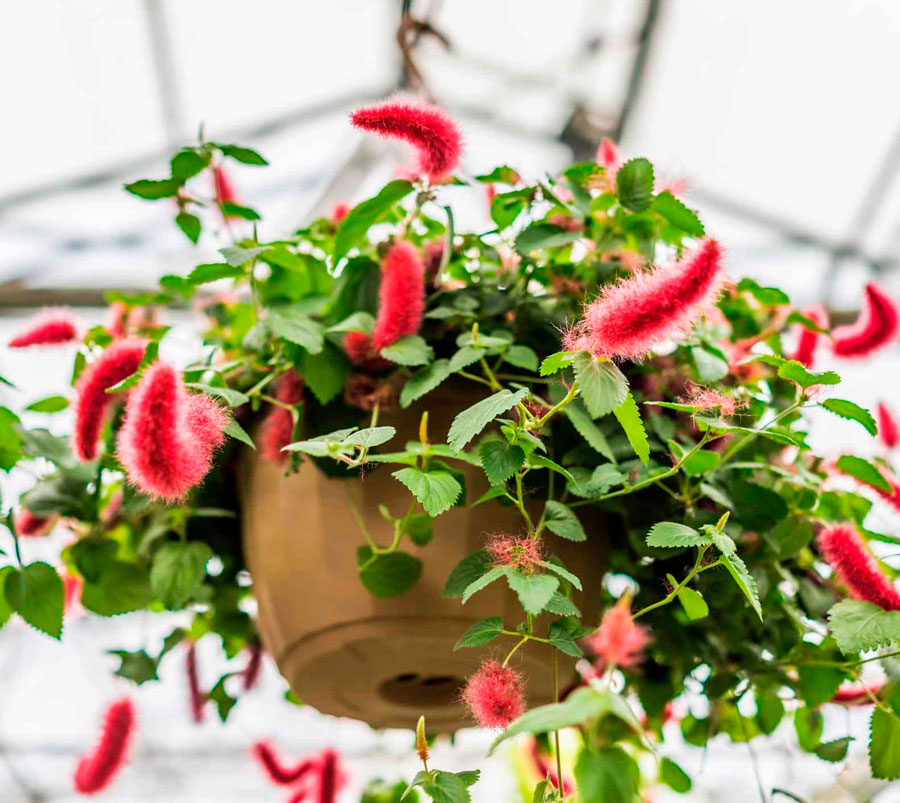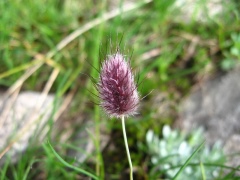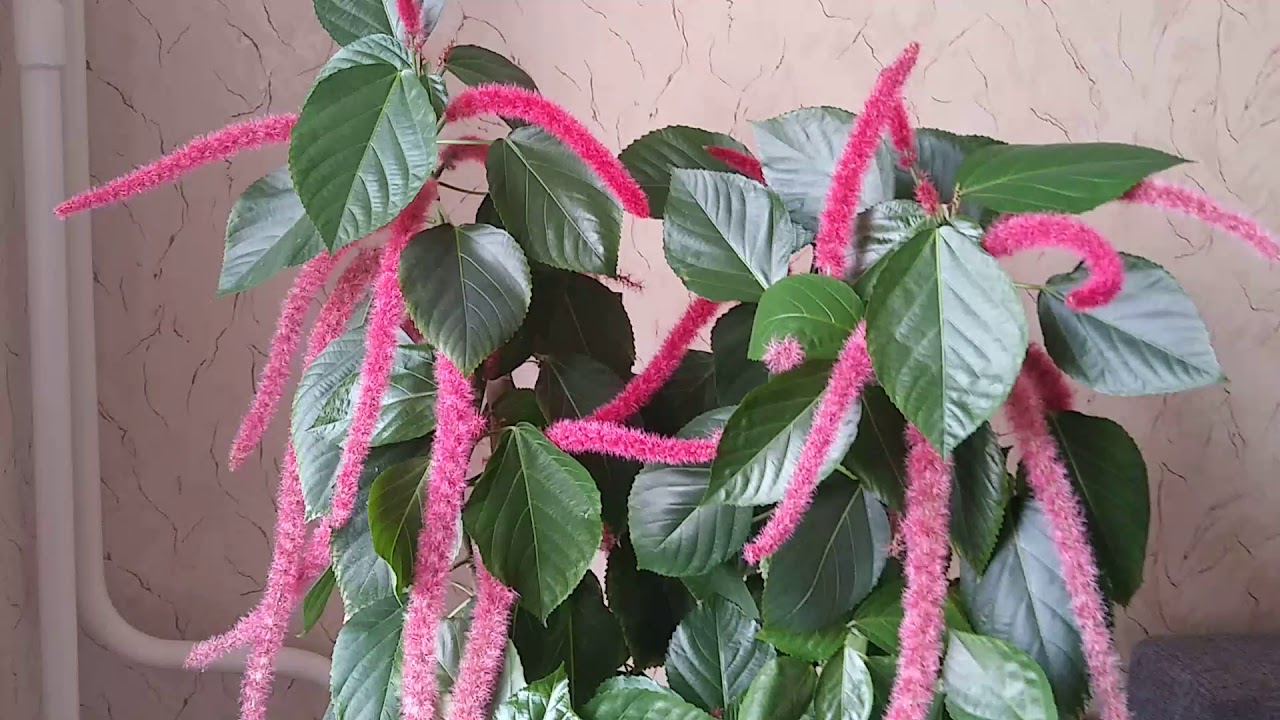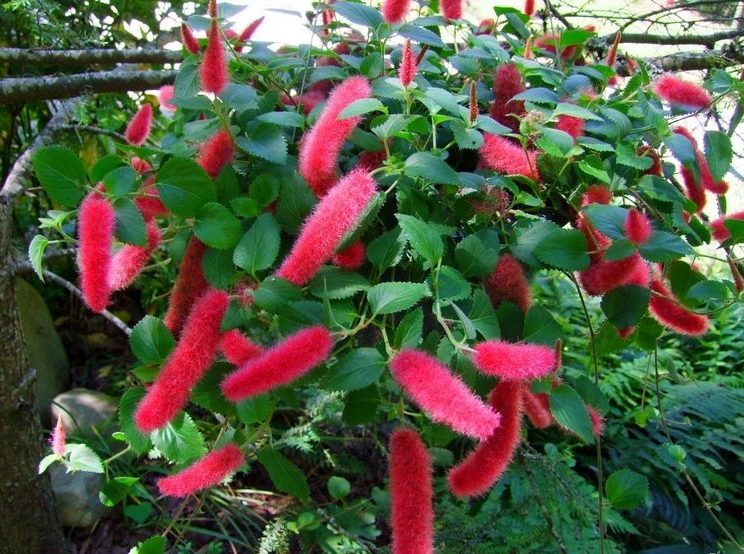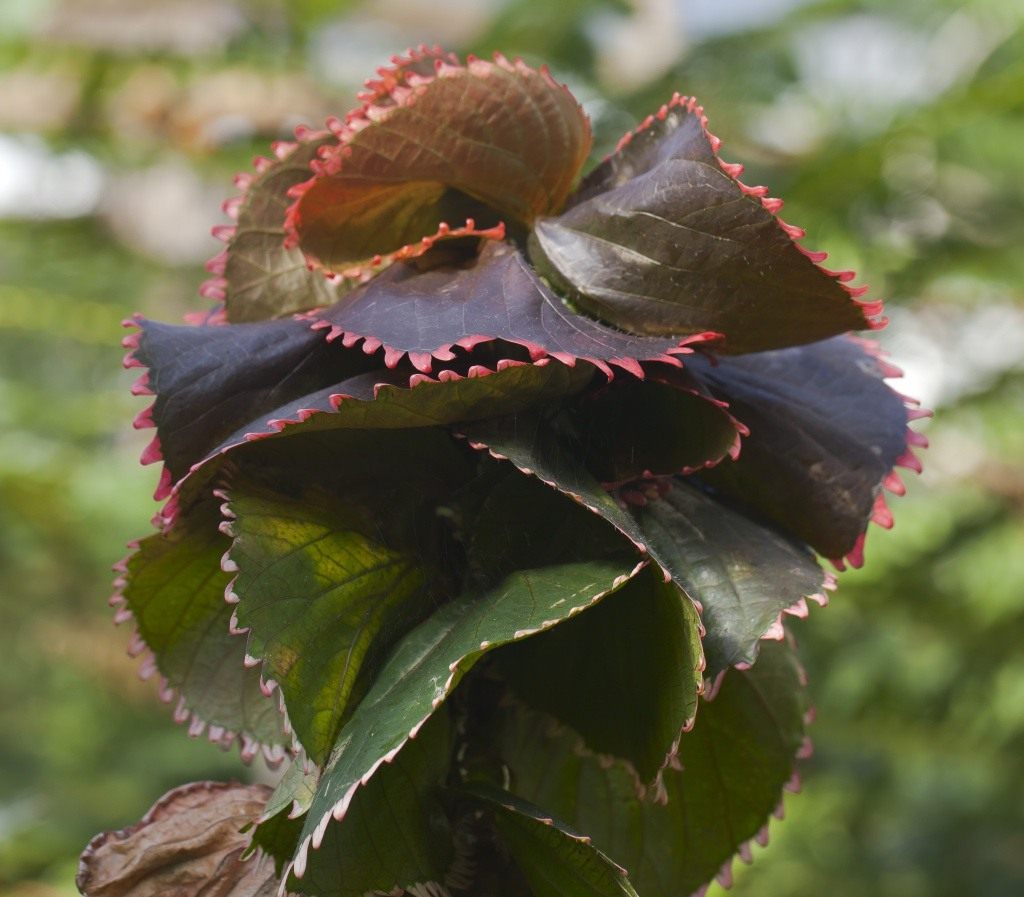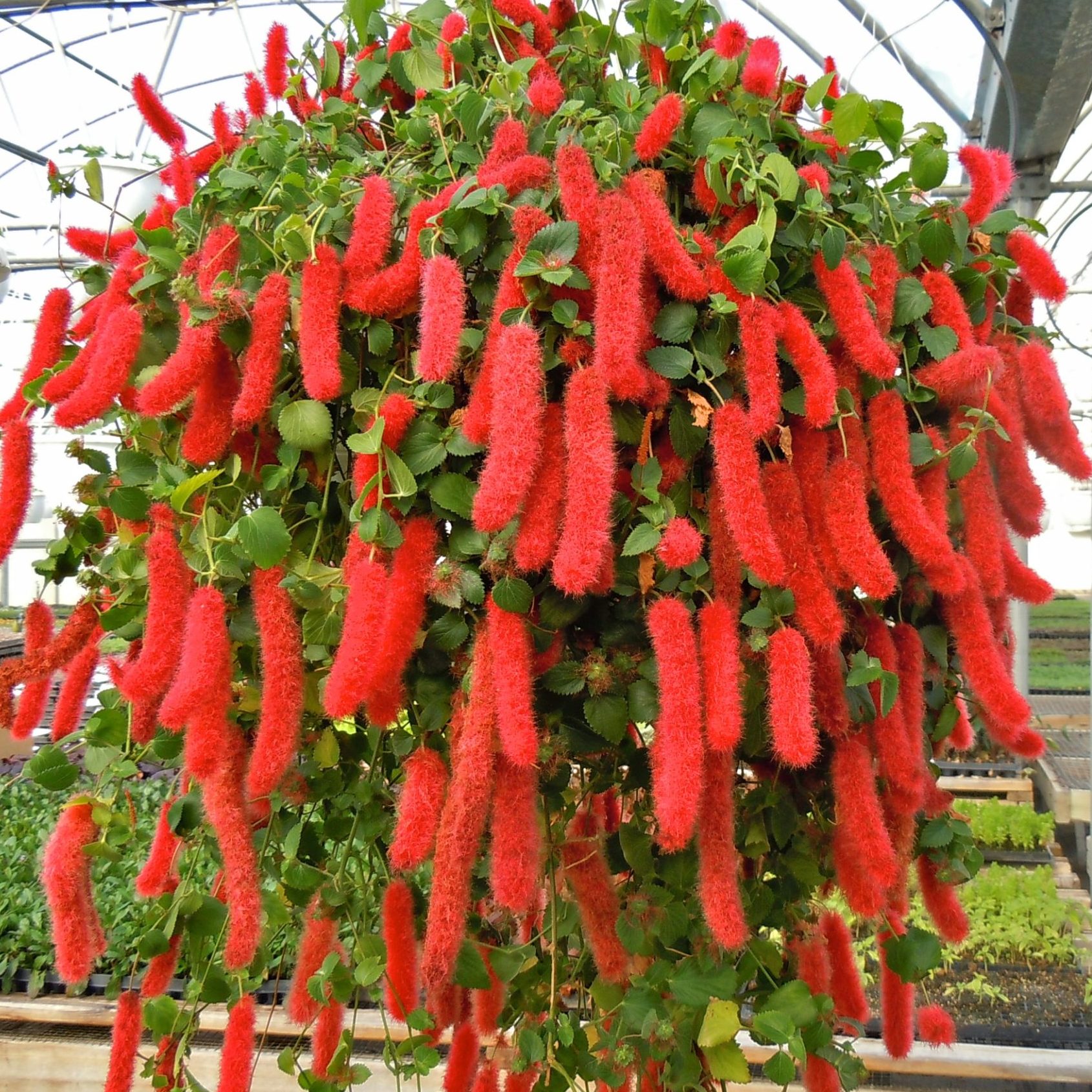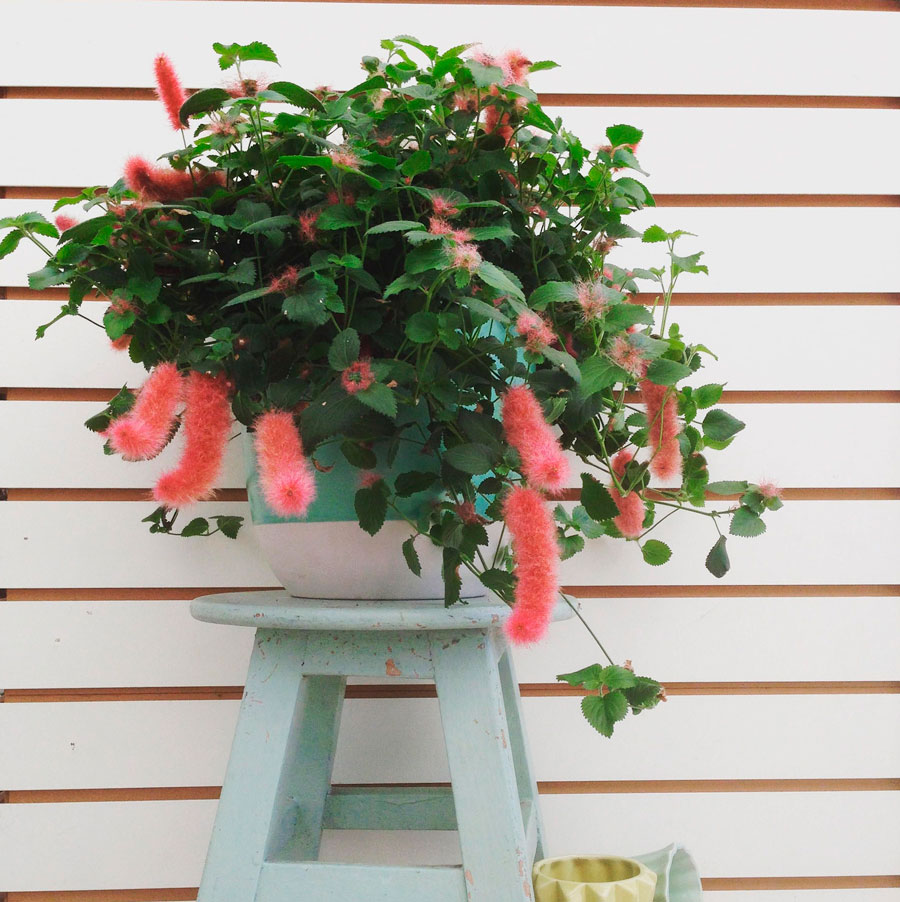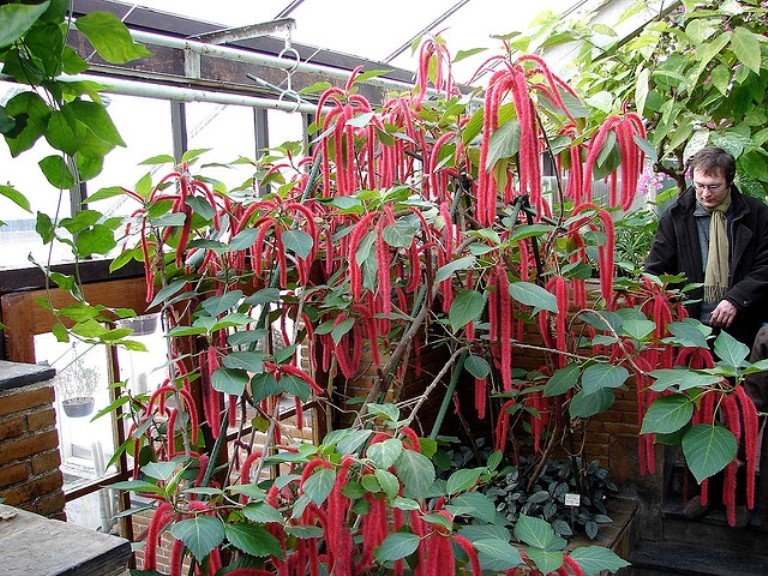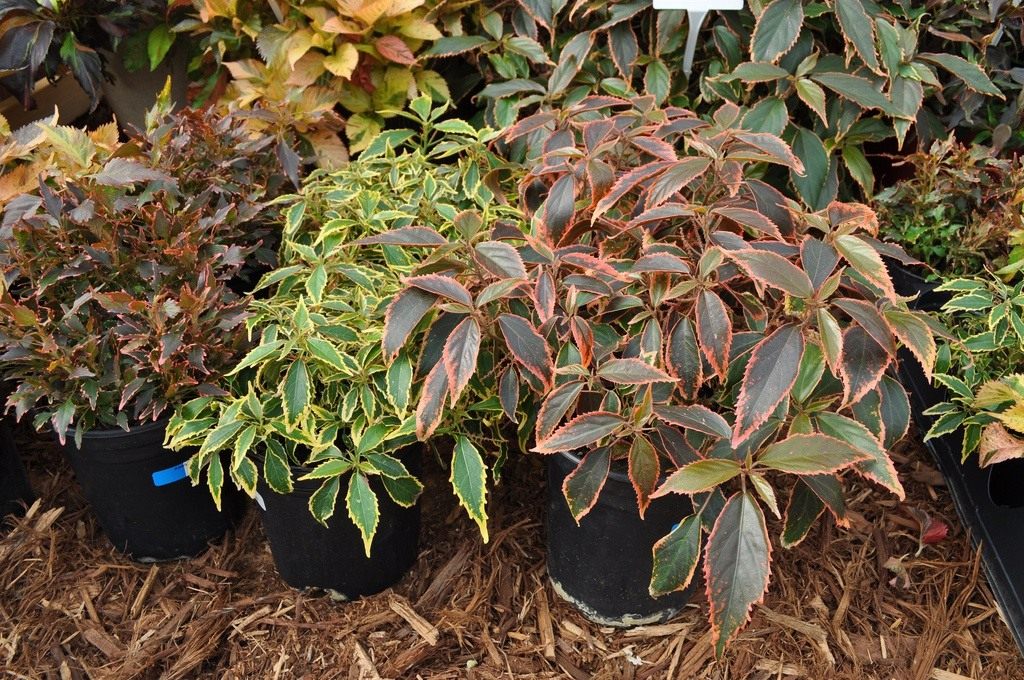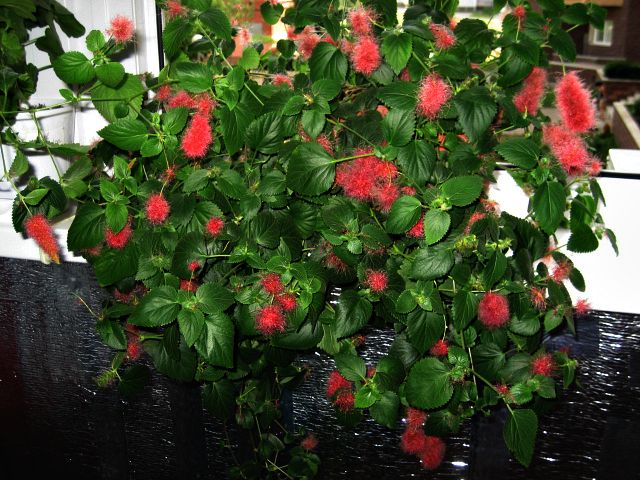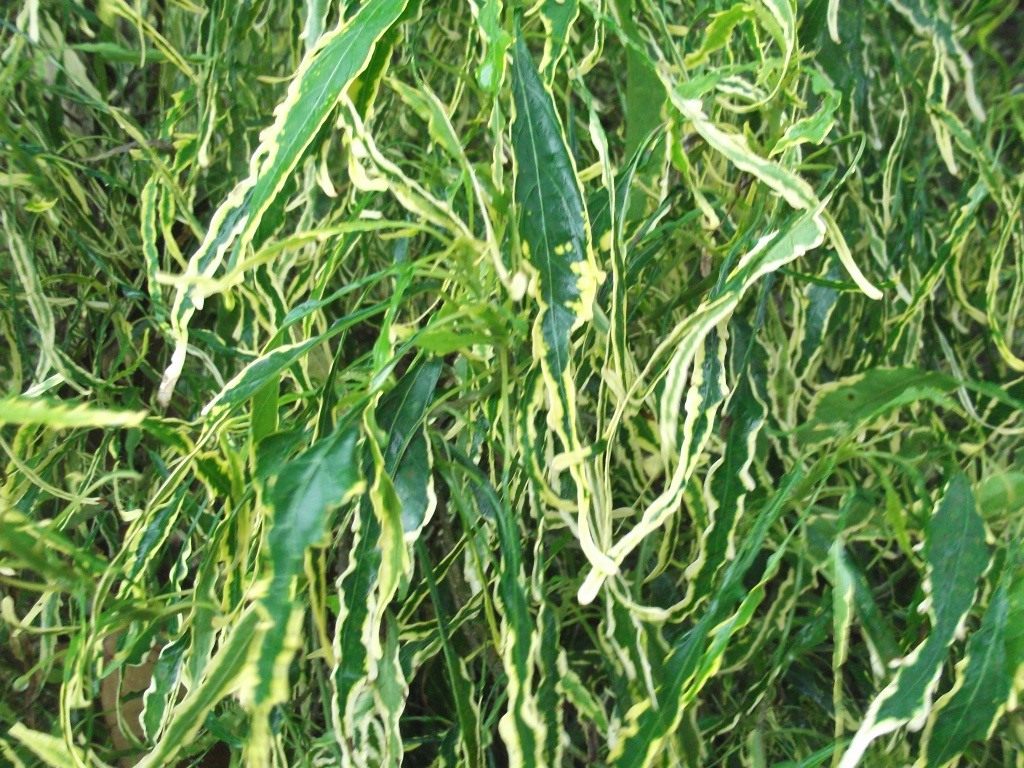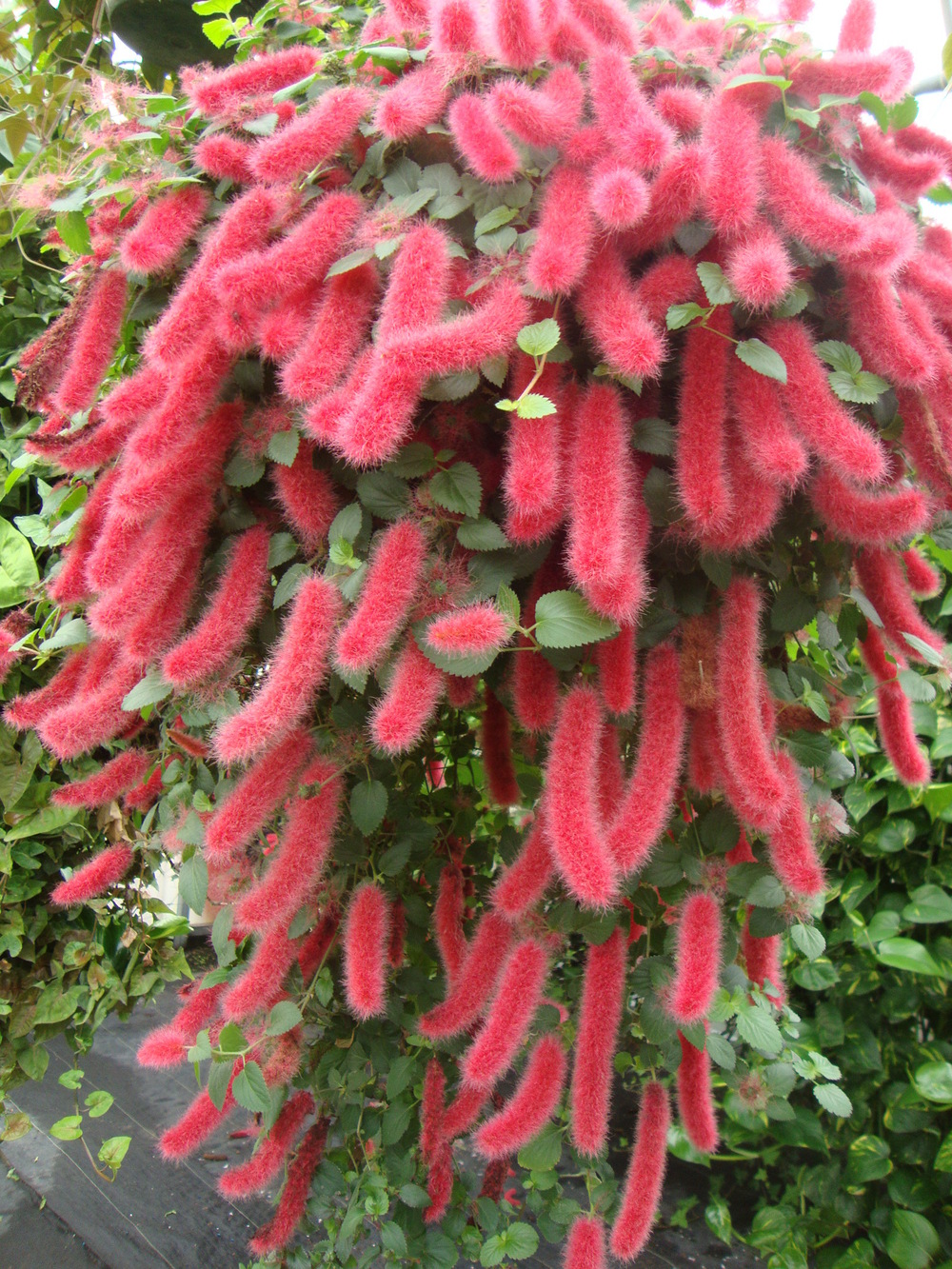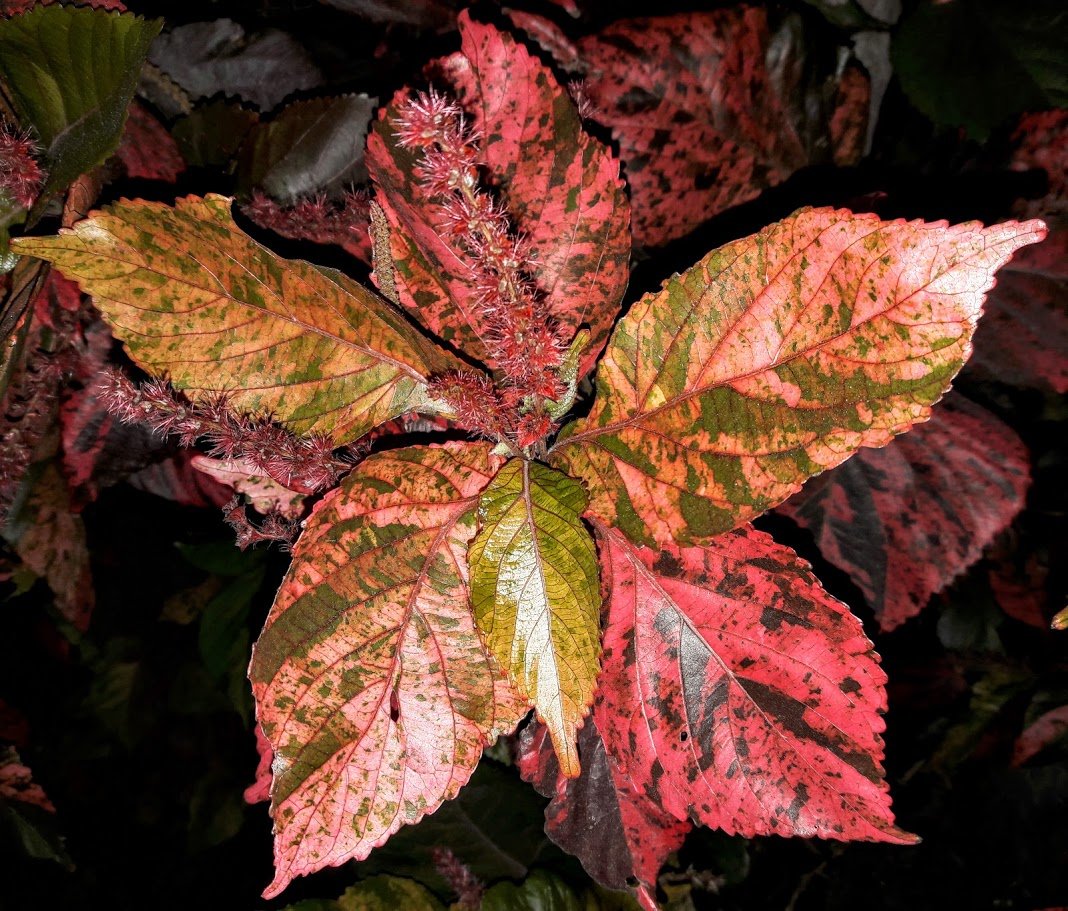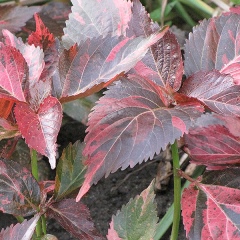Akalifa Viginsi
The representative of this species can be found only on the Galapagos Islands and that is quite rare - the plant is on the verge of extinction. Akalifa Viginsi is a large shrub with long fluffy crimson inflorescences. According to scientists, measures should be taken immediately to preserve the species, otherwise it will be possible to forget that once this beautiful flower grew on planet earth.
Akalifa is an ornamental houseplant, which is still exotic for many flower growers. There are a lot of species of this flower, and each of them is attractive in its own way.
Some varieties are distinguished by continuous and original flowering, like the akalifa hispida. Descriptions of other species indicate unusual leaf coloration. All varieties are united by one excellent quality - unpretentious care. This plant will not only decorate the house, but also give a sea of positive emotions with its flowering.
vote
Article Rating
Pruning and replanting
The fox tail plant quickly grows new shoots. Young akalifs are transplanted every year. In mature plants, the pot of soil is renewed as needed. It is enough to transplant once every 4 years, but the plants grow so quickly that they need to be transplanted and pruned much earlier.
The transplant is performed with a change in the size of the pot upward. The substrate should consist of a mixture of sod, deciduous soil and humus with the addition of sand.
With the help of pruning, you can update an old one or form a new bush. To update a heavily overgrown ugly plant, it is necessary to cut off absolutely all the stems, leaving hemp 15-20 cm high.In the first weeks, the bush will look ridiculous, but after a month new branches with young beautiful leaves will begin to grow from the buds on the remaining stems and from the roots.
In order for a new crown to form on the trimmed bush faster, it is recommended to place the pot under a film so that the flower is in conditions of constant high humidity. When new young branches appear, the film can be completely removed, after which you can take care of the flower as usual. Spraying the plant with a solution of zircon, which is diluted in water at the rate of 2 drops per 1 liter of liquid, has a beneficial effect on growth.
Reproduction
These plants can be propagated by seeds, apical cuttings and air layers.
Seed propagation
Sowing is carried out in March-April, in light soil, consisting of coarse sand and leafy soil in a ratio of 1: 1.
Cover with polyethylene and contain, periodically ventilating and moisturizing, at 20-22 degrees. With the lower heating, the seeds germinate faster.
The grown seedlings are planted in a denser soil and grown, protecting them from direct sunlight.
Propagation by apical cuttings
In March, beautifully flowering species of akalif are propagated by cuttings. Cuttings of deciduous ornamental forms are rooted at any time of the year.
Semi-lignified top shoots, shoots 7-8 cm long are sent for rooting at 20-25 degrees in a moistened mixture of sand and peat.
Cover with polyethylene, ventilate, spray, moisten the substrate.
When rooting has occurred and new shoots have appeared, the cuttings are planted in more nutritious soil - several pieces can be in one container so that the shoots grow and bloom together.
New "fox tails" are gradually accustomed to bright sunlight; as they grow, pinch young shoots.
Propagation by air layers
The middle part of the shoot is fixed in moist sphagnum in spring. By the beginning of the next spring, the cuttings are well established and can be cut off from the mother plant.
Diseases and pests
Proper care of the plant is the key to health and an attractive appearance. Subject to all agrotechnical subtleties, the plant develops well, has dense foliage of rich color, long flowering.
- Yellowing drying leaves warn that the plant is experiencing a moisture deficit. It is necessary to change the water regime, water regularly and spray abundantly.
- The edges of the leaves turn brown, dry out and break off, the leaves shrink. The reasons for such changes: lack of minerals in the soil, excess or lack of water. Try replanting the plant, giving it more attention, and remembering to water and spray.
- Elongated thin shoots, poor plant development, complete absence of flowering signal an acute lack of light. Changing the place to a more sunny one or providing additional lighting with special phytolamps will help.
- Leaf fall occurs in dry air at the height of the heating season. Measures to humidify the air will help prevent leaf fall. Perhaps a simple spraying of Akalifa will not be enough, therefore, it is necessary to use a set of measures: a bowl of water, a pallet with wet expanded clay, an air humidifier.
- The plant does not develop and does not bloom, although outwardly it looks healthy - it may lack nutrients. Nitrogen, which is part of all fertilizers for indoor plants, mobilizes the strength of the plant. In general, timely feeding guarantees the development of a plant with a strong immune system, which itself copes with the external harmful environment.
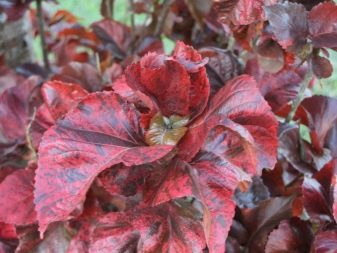

A diseased plant must be isolated and all preventive measures taken.
- This will help not only special chemicals, but also homemade ones, which are always at hand. So, tar or ordinary laundry soap without chlorine will help prevent the spread of aphids and mites.
- To combat various types of parasites, an ordinary shampoo for animals will help, which contains substances that kill ticks, while minimizing damage to the plant.
- Brown or mealy spots, appear on the leaves when damaged by a fungus, are well treated by treatment with a fungicide. It is recommended to repeat the treatment after 10 days.
- As a preventive measure, spraying the plant with a weak solution of horsetail helps well.
- The pests parasitizing on akalif feed on its juice and multiply. If you do not show active measures, the plant may die. Treatment with systemic insecticides will help get rid of flower aphids, scale insects.
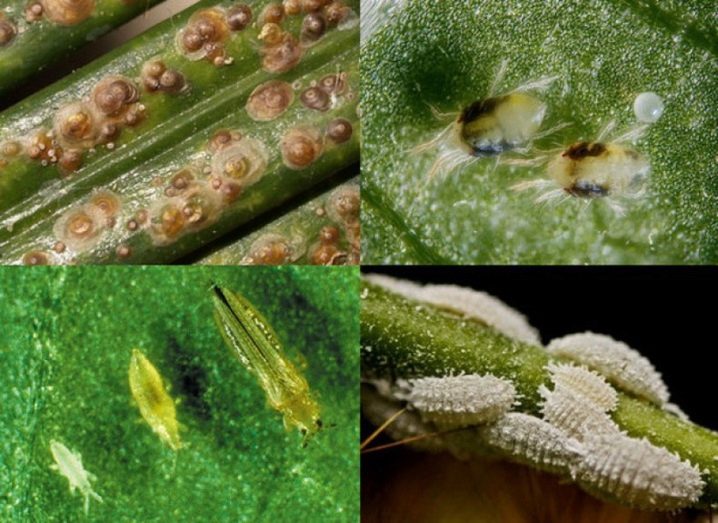
For information on how to properly care for akalifa, see the next video.
Akalifa - home care
This original flower is native to Latin America and belongs to the euphorbia family. In the wild, the plant can reach impressive sizes - some varieties grow up to 2 meters in height.

This indoor flower is very unpretentious.
Description of the plant
The name "akalifa" translated from ancient Greek means "nettle". This is because the shape of the leaves of both plants is similar. The color of the leaf plate cannot be described unequivocally, since it can vary from light green to dark purple, depending on the variety of the flower.
Inflorescences in most varieties are fluffy and flowing, spike-shaped. They have a rich crimson or red hue. Varieties with variegated foliage do not bloom so effectively - their flowers are small and rather inconspicuous.
Variety of species
There are more than 400 species of akalifa, but not all are suitable for growing in indoor conditions. Most often, flower growers grow bristly-haired Akalifa, Wilkes and several other varieties. They can be conditionally divided into two groups:
- Varieties that feature abundant and continuous flowering. Against the background of lush greenery, fluffy spike-shaped inflorescences of a raspberry hue stand out. Some species can be grown as an ampelous plant.
- Varieties with an unusual color of the leaf plate. Thanks to the variegated foliage, they look spectacular and decorative. Inflorescences are small, red.
The variety of types of akalifa makes it possible to choose the most suitable variety for each purpose. Lovers of original greenery are more suitable varieties with variegated foliage, and those who prefer to grow flowering plants - varieties with bright inflorescences.
Akalifa as an ampelous plant
Some flower varieties have long, flowing shoots. This makes it possible to grow them as an ampelous culture.

Very decorative ampelous varieties
Important! Most often, flower growers choose a Haitian Akalif for this purpose. Its shoots are of a suitable length and shape.
Varieties of indoor flower akalif
Depending on the variety of the indoor flower akalif, the jagged leaves can vary in color from green with edging to brown with gray spots. And some species are represented by very narrow leaves.
The color scheme of the flower can also vary, but we will note the most popular ones - red-brown, bright red, pink, orange, green and cream.
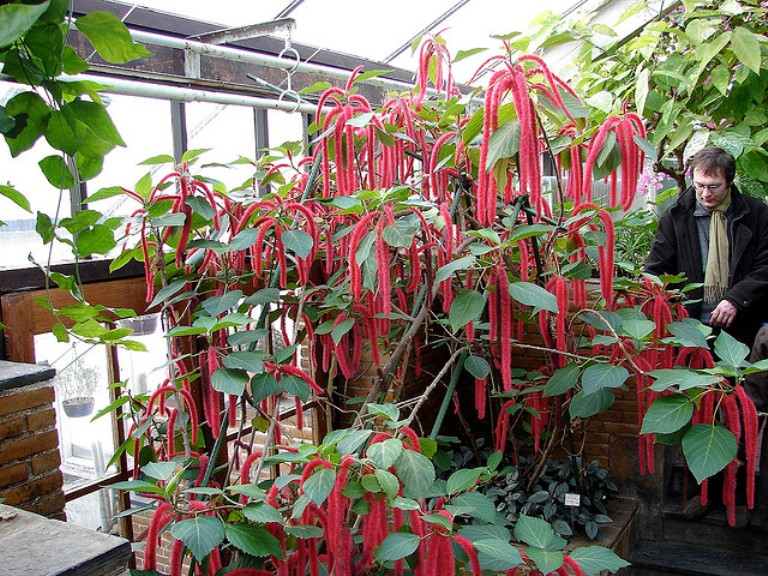
According to modern scientists, the species has more than 400 subspecies. It is clear that within the framework of the article we will not be able to tell about all of them - we will touch upon only a few of them.
Alba - its main distinguishing mark is its white flowers.
Acalypha hispida - grows in Hawaii and Oceania, and each country has its own name for this subspecies. It can reach up to 1.5 meters in height, but in a potted version it is about half as much. Grown from both seeds and cuttings.
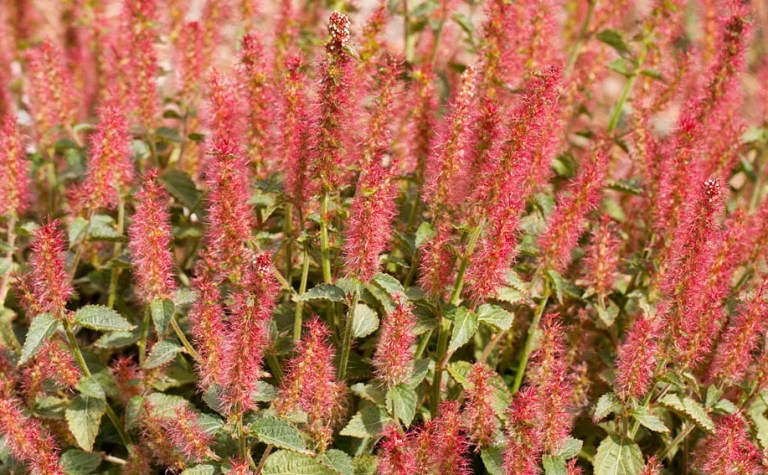
Acalypha australis is a subspecies native to East Asia. It reaches a height of about half a meter, has oblong leaves. The flowers form inflorescences up to one centimeter long. The female has three sepals and the male has four.
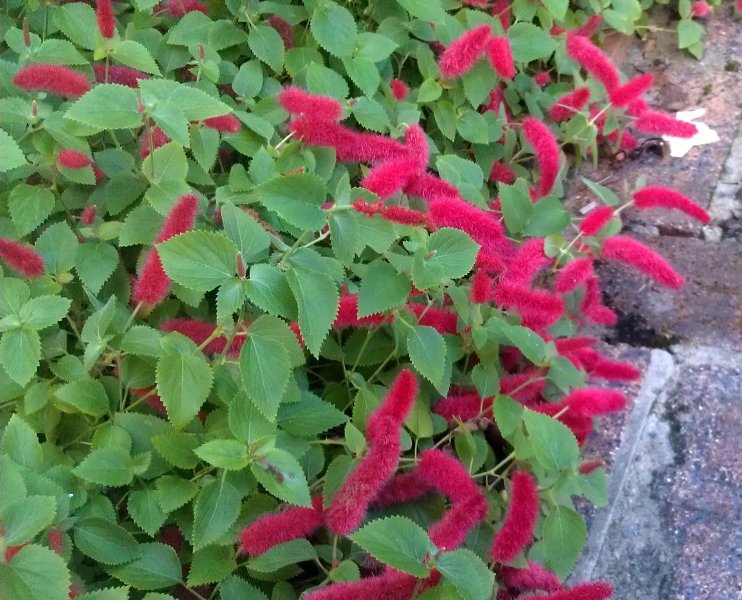
Acalypha bipartita is widely used in regions of Africa, where the product is used as the main vegetable, or simply fed to animals.
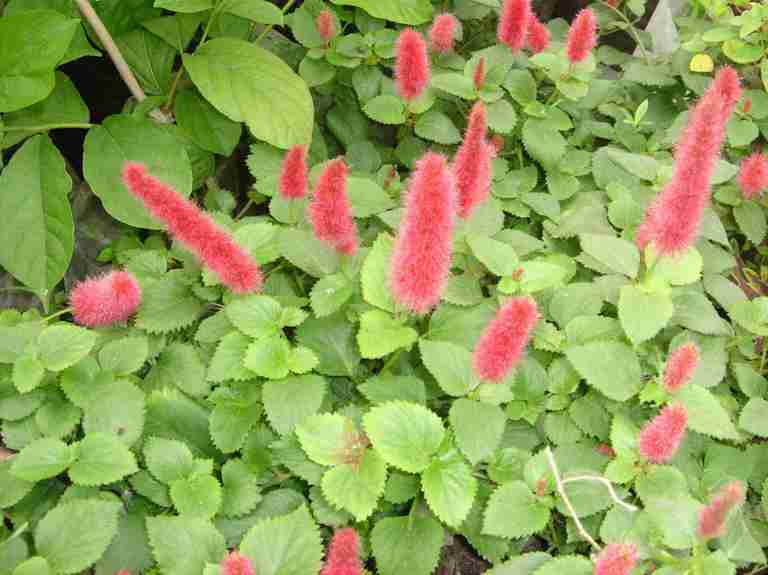
Acalypha californica is the only species native to California (not Asian and African countries). It has jagged leaves in a light green color, and each flower is composed of stamens in the form of long thorns of red and pink flowers.
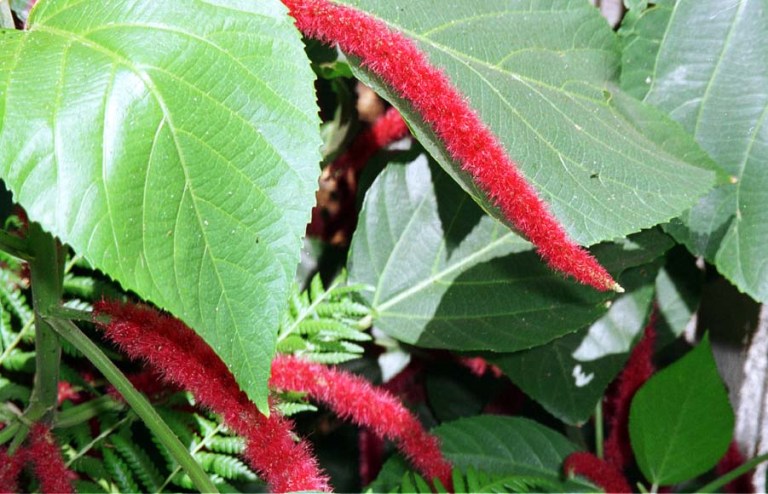
Acalypha ciliata, it also lives in Africa and is consumed by the locals as a vegetable, or fed to animals. But in the Eastern and Western regions of the mainland, it is used as a medicinal plant. Otherwise, he is not much different from his fellows.
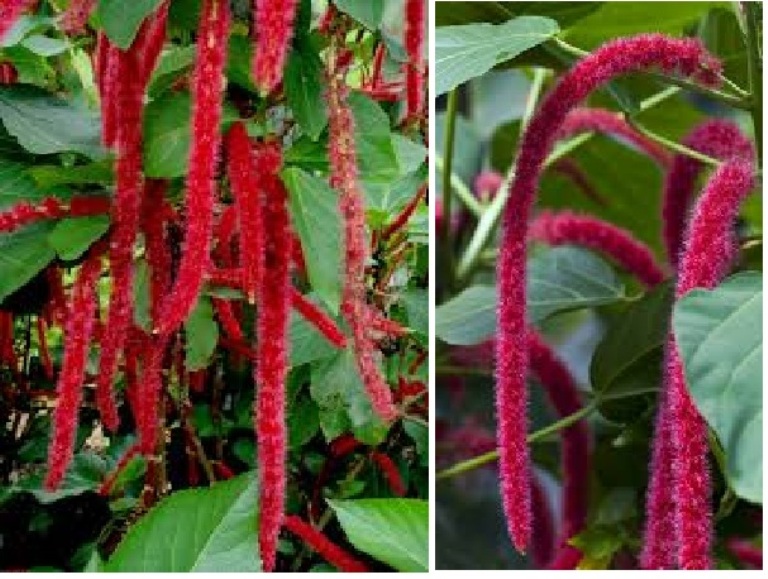
Acalypha dictyoneura is grown in Ecuador and has over six known populations.
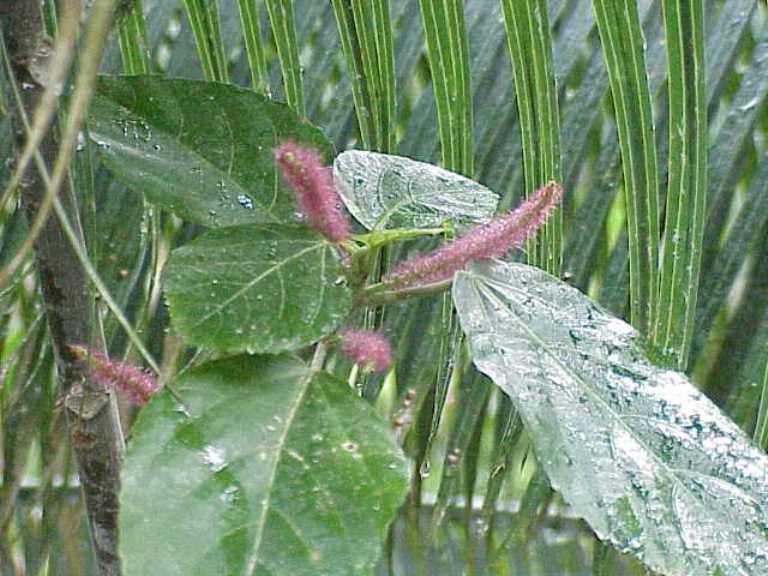
Acalypha indica is native to tropical Africa, India, Sri Lanka, Yemen and Pakistan. According to one version, it was originally a common weed. The plant can reach height up to 75 cm with leaves egg-shaped., which one use as a vegetable, and others as a medicine (it is believed that it helps to rejuvenate the body, treats scabies and helps to cope with shingles).
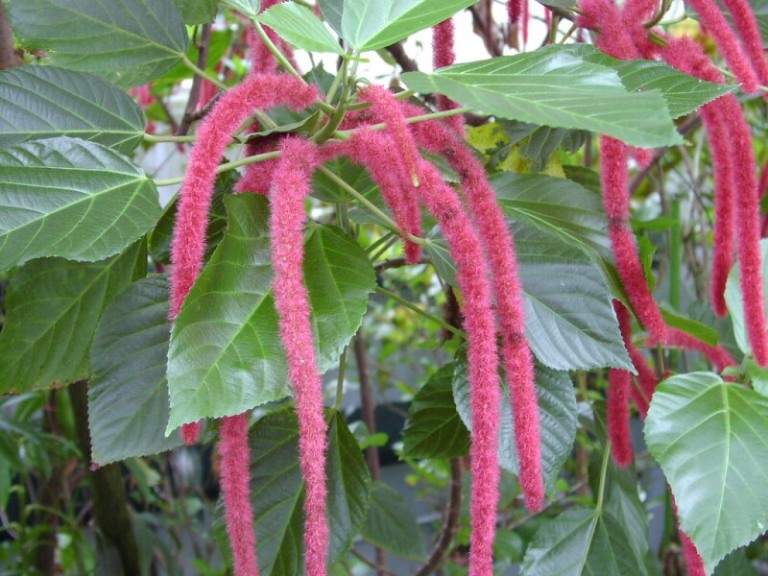
Acalypha wilkesiana can be up to three meters long. It has a straight stem with many branches and leaves up to twenty centimeters long copper-green with red splashes - this makes them variegated and interesting, which causes the interest of gardeners and housewives in their reproduction, as well as use in home gardens.

What does an akalifa look like?
In nature, Akalifa is a shrub about 2 m high, the dimensions of indoor plants are much more modest.
Akalifa (Acalypha), she is "fox's tail" or "cat's tail" - a genus of evergreen herbaceous plants and shrubs (very rarely - low trees) belonging to the Euphorbiaceae family, numbering about 450 representatives. Its name comes from the ancient Greek "nettle" and is due to the external similarity of the leaves. It is really easy to confuse them - both the shape (ovoid, with a pointed tip and an edge cut out with triangular teeth) and the color are similar. The presence of rare thin bristles is also characteristic of the well-known weed.Somewhat less often at home, there are other akalifs - they bloom less effectively, but the leaves have an unusual bronze or copper tint, covered with dark scarlet spots.
The homeland of Akalifa is the tropics. The most common plant in Southeast Asia, Australia, on the islands between these continents. Some species are found in South and North America.
Like other Euphorbiaids, Akalifa is poisonous. All parts of the plant contain a caustic milky-white juice, which is highly irritating to the skin and even more to the mucous membrane.
... In especially severe cases, even allergic reactions such as Quincke's edema are possible. Any work with a flower is carried out only with gloves. When finished, be sure to wash your hands. Also, choose a location that small children and pets cannot reach.
The main value of akalifa in the eyes of a grower is spectacular spike-shaped inflorescences. In nature, their length reaches 50 cm, at home 30 cm. These bright, beautifully flowing shaggy brushes in natural conditions stay on the plant for several months. In captivity, the plant blooms even more readily, almost continuously, at least from late winter to mid-autumn.
Blooming Akalifa, with proper care, pleases the eye almost all year
The undoubted advantage of the flower is its compactness. In nature, akalifa can grow up to 2 m tall, at home it is rarely taller than 50–70 cm.
Akalifa looks good not only on the windowsill, but also in hanging pots
Variety of species
Akalifa has many types. Here are the most famous and popular ones:
Akalifa Hispida
In the description of the akalifa hispid it is said that its other name is akalifa bristly-haired. It is a small indoor flower with long inflorescences (about 45 cm). Their color can be dark pink or red. Outwardly, they are very similar to birch catkins. The leaves are thin, dark green, covered with branched veins. The edges are slightly serrated. Long and lush flowering.
Akalifa south
This species does not stand out in any way. Akalifa southern is a common weed. Its stem is straight and branched, reaching a height of half a meter. Flowers of two types: staminate (below) and pistillate (above). Inflorescences are spikelets. Blooms from July to August. The fruits are formed in August-September and are formations with hard hairs. The color ranges from gray to light brown.
For your information! Such an annual plant is very tenacious, so herbicides should be used to destroy it.
Akalif Wilkes
This species is prized for its rounded leaves with a bronze tint and crimson spots. That is why it got its second name, copper sheet. Foxtail eventually turns into a tall bush, but there are also miniature specimens. Rare flowers also surprise with their red color, but they are still not as impressive as catchy leaves.
Akalifa Viginsi
The homeland of the endangered species is the Galapagos Islands. Due to the vigorous activity of people, this species practically does not occur in nature. It has wide, elongated leaves with sharp tips. Inflorescences are bright red, hanging.

Propagation by cuttings
Akalifa can rightfully be considered a very diverse plant. Numerous representatives include both attractive flowers and weeds. However, among the large selection, you can definitely find what you want. This plant will be an ideal decoration for any room, whether it be an ordinary apartment, a cozy country house or an office study.
MAGIC OF FLOWERS
Akalifa room. Fox Tail Nature creates amazing things that man tries to tame. From the tropics of Australia and Southeast Asia, an unusual thing happened ...
Read More
Asters. Growing and Care When summer greens begin to change color to gold, colorful suns appear in the garden. These are asters - alone ...
Read More
Primula room.Primrose Flower growers, when choosing flowers, give preference not only to the beauty of appearance, but also to compactness, minimalism and size ...
Read More
Babiana. Garden flower. Care and cultivation of Babiana is a tropical plant in South Africa, with an interesting name, which it got from baboon monkeys, because baboons ...
Read More
Periwinkle. Magic violet Periwinkle is a permanently green, perennial plant that covers the surface of the earth with a thick rug. Not picky about leaving. The surface of the leaves of the plant ...
Read More
Smithiante. Flower of the 10 Commandments There are indoor "green pets" that combine the signs of several plants in their appearance. However, his abilities and ...
Read More
Pansies. Troyesvetka Among florists, there are numerous warnings or tips about Pansies. Despite their pleasant appearance, the ancestors ...
Read More
Pion
Maryin root I would like to draw attention to a representative of the flora called Peony. A flower that is not picky about natural conditions is attractive ...
Read More
Lily of the valley, aka Rejuvenator A wide variety of colors requires a global study of each representative, not only in terms of external characteristics, but also in ...
Read More
Varieties and photos
Since there are more than 400 varieties, it is impossible to create a single accurate description of the plant: perennials, annuals, trees, and shrubs, and even herbaceous crops are found in the group. But there are some common features. For example, these are flowers that delight the eye all autumn and winter: long, covered with numerous villi. Their shade depends on the variety.
Below are photos of the main varieties of akalifa, suitable for reproduction and care at home.
Wilkes (Acalypha Wilkesiana)
An evergreen shrub with a dense and so lush crown that the flowers are almost invisible. It grows up to two meters in height. The stem is straight, strongly branched, covered (like branches) with fine short hairs. Leaves are oval, with pointed tips, 5 cm wide and 13-15 cm long, slightly pubescent, covered with purple or copper veins. In the dark, they acquire a greenish tint, in the sun - orange. The flowers are unsightly. The homeland of the variety is the island of Fiji. The photo below shows Akalif Wilkes:
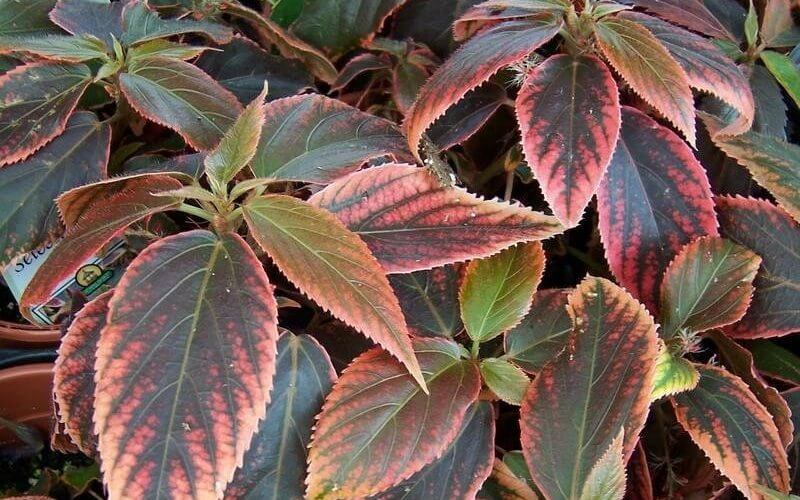
Bristly hairy (Acalypha hispida)
Under natural conditions, representatives of this variety reach a height of up to 3 meters, but under indoor growing conditions they barely reach up to a meter. The birthplace of bristly haired akalifa is Polynesia. Its flowers are most often bright scarlet (there are also white), pubescent, up to 50 cm long. It can bloom all year round with good care. What the bristly-hairy variety looks like can be seen in the photo below:
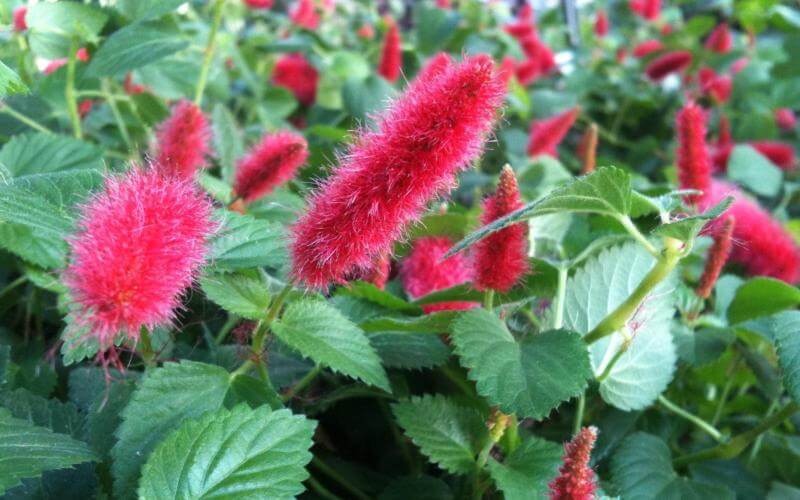
Bristly or rough (Acalypha hispida syn.Acalypha sanderi)
The most popular decorative type among flower growers. The stems are straight and long (up to half a meter in height), the leaves are elongated, with carved serrated edges. Inflorescences of a juicy raspberry hue, there are also snow-white specimens. It blooms all year round, the buds are collected in fluffy long inflorescences and resemble earrings. In the photo below, the variety is Bristly or rough:
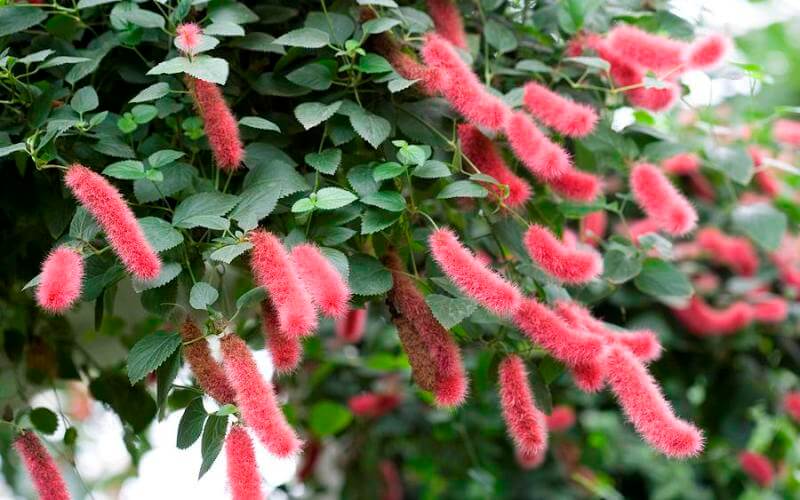
South (Acalypha australis)
This annual variety grows abundantly in the Far East and Caucasus and is considered a weed. It stretches in height up to 6-7 meters, but the leaves are very small - 1.5-2 cm. The shape is both lanceolate and oval, with pointed tips. Flowers are small, collected in spike-shaped or apical inflorescences. The flowering period is from July to August. The photo below shows the South Akalifa:
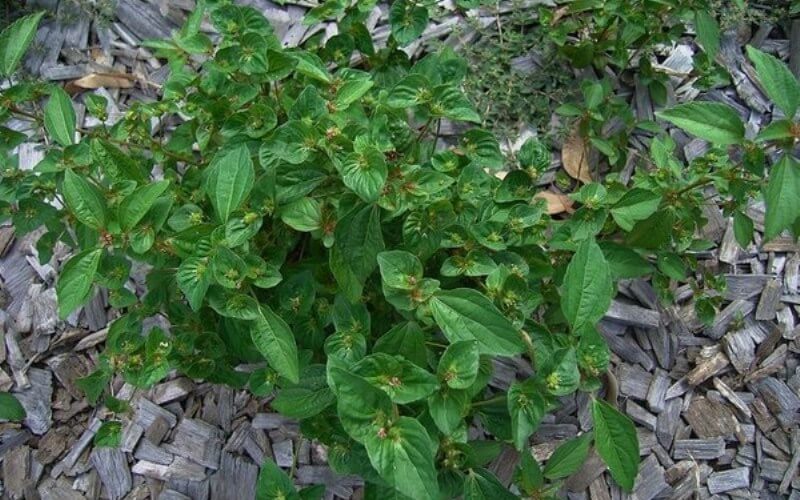
Akalifa: home care
It is not difficult to take care of akalifa at home, but do not forget about caution when working with a plant. Otherwise, the following symptoms are possible:
- skin rashes;
- tearing;
- headache.
Other nuances of caring for such a plant:
Temperature and lighting
Foxtail is a heat-loving plant. You cannot take him out into the street, since gusts of wind can harm him. The house should be placed in a place where there are practically no drafts.
Illumination is a very important factor. Akalifa prefers bright, but diffused light.
At a low level of illumination, decorativeness can deteriorate:
- the leaves will turn pale;
- flowering will worsen;
- the stem will stretch out and take on an ugly shape.
For your information! The optimum temperature for a foxtail is about 25 ° С, in winter - not lower than 16 ° С. If these rules are not followed, the Akalifa will start to hurt and may die.
Watering
Foxtail is a plant with rapid growth and development, so it requires repeated watering. In the period of cold weather, it should be reduced. When the heat comes, the ground should always remain moist.
Important! To make the plant feel comfortable at home, it is worth placing the foxtail pot in a tray with damp pebbles. Humidification with a spray will also do the trick.
Fertilizers
It is necessary to feed the plant during intensive growth (from March to September). Complex mineral fertilizers are ideal for this purpose. Top dressing is done 2 times every 30 days. The use of organic fertilizers is also possible.
Transfer
Young foxtails are transplanted annually, adults - once every 3-4 years. Growing a foxtail for more than four years is pointless, since it stretches a lot. Without rejuvenation, the plant will lose its decorative effect in the third year.
Overgrown foxtails are replanted using the transshipment method with renewal of the topsoil. It is also necessary to cut the shoots in half. The best time to transplant Akalifa is spring.
Important! The plant prefers light soils with sufficient air and cultivation capacity. The optimal soil mixture should include equal proportions of sod and leafy soil, as well as peat, humus and sand.
Pruning
To keep the old specimens attractive, you need to cut off the entire upper part, leaving a stump 20-30 cm high.Then it should be covered with a bag or glass cap, so the plant will give young shoots faster.
For your information! For accelerated growth, you can use a zirconium solution, which is sprayed on the stump.
Reproduction
Akalifa can propagate with the help of seeds or by cuttings. Seedling production begins in March-April. Seeds are planted in a soil mixture of leafy earth and sand (1: 1). The temperature should be in the range of 20 ° C, and it is best to place the seedlings in a mini-greenhouse, where the seeds will develop more quickly.

Propagation by cuttings
For grafting, semi-lignified apical cuttings are taken. Before planting, the cuttings are treated with a root-forming stimulant. A container with a young plant is placed in a greenhouse or covered with polyethylene. After 45-60 days, the tip is pinched so that the foxtail bush better.
Important! Akalifa bristly-haired should undergo reproduction only in spring. Peat-sand (1: 1) substrate is used for rooting.
Possible plant problems
In case of violations of care, the Akalif can be attacked by aphids, worms and bladders.
When the foxtail is in relative coolness and low humidity, the leaves will begin to turn yellow and fall off. Spotted placers may occur - a manifestation of fungal diseases. With a lack of nitrogen, the leaves lose color and become pale. Acaricides and drugs against parasites of direct use will help to correct the situation.
Caring for akalifa at home. In detail
Flowering akalifa
The flowering period of akalifa is not tied to a specific season and can last all year round. The inflorescences of the plant consist of many small crimson-red flowers, collected in fluffy ears, the length of which in some varieties reaches half a meter.
In order for the akalifa to retain its decorative effect, fading flowers must be removed from it regularly.
The heat-loving Akalifa feels comfortable in a room, the air temperature in which in summer is + 21- + 25 ° С, in winter - + 12- + 16 ° С. temperature to the minimum, the flower will slow down in growth and may get sick.
In addition, drafts are dangerous for akalifa, so it is not recommended to take it out into the fresh air even in summer.
Spraying
The tropical plant akalifa at home needs to maintain a constantly high humidity of the surrounding air. Throughout the growing season (with the exception of the flowering period), the Akalif should be regularly sprayed from a spray bottle with warm, settled water, directing the spray nozzle directly to the foliage, but slightly higher.
Domestic akalifa is very photophilous, but it should still be protected from direct sunlight. The best place to place the plant is the western or eastern window, you can put the flower pot on the southern windowsill, but during the hours when the sun is especially active, the plant will have to be additionally shaded. But in the constant shade, the Akalifa quickly loses its decorative effect: its shoots stretch out, the leaves turn pale and shrink.
Watering the Akalifa throughout the year should be regular and moderate, preventing the earthen coma from drying out
It is especially important to monitor soil moisture on hot summer days.
In winter, watering is reduced to the minimum required.
Pot for akalifa
Akalifa grows best in a cramped pot, but go to extremes and choose a very small container for a flower. The root system of the plant should fit comfortably in the pot and be able to grow further.
Akalifa does not impose special requirements on the composition of the soil, it is only important that the soil is light enough and passes moisture and air well. The optimal composition of the substrate for the plant: turf and leaf land, peat, humus and sand, mixed in equal proportions
Top dressing and fertilization
Caring for akalifa at home must necessarily include regular fertilizing with complex mineral fertilizers, which should be applied from early spring to mid-autumn every 2-3 weeks.
Organic fertilizers (for example, vermicompost) can be periodically used as top dressing.
Akalifa transplant
Young specimens grow very quickly and should be transplanted into larger pots each year. The transplant of akalifa, which has reached adulthood, is carried out every 3-4 years, and old highly overgrown specimens can simply be transferred into a new container every few years or periodically renewed in a permanent pot the top layer of soil.
Pruning akalifa
To make the plant look neat and well-groomed, it is subjected to formative pruning every spring, during which the shoots are shortened by at least half their length. Once every few years, Akalifa is rejuvenated by pruning all its stems to a height of 20-30 cm. To accelerate the "overgrowth" of stumps with young shoots, the plant can be sprayed with a solution of zircon.
Akalifa does not need a full rest period at home. A reduction in daylight hours can be a signal for a short-term rest of the plant, at this time it is necessary to reduce the frequency of watering and suspend the application of fertilizing.
Reproduction of akalifa cuttings
The vegetative method of propagation is suitable for all types of akalifa with some reservations: variegated varieties can be grafted year-round, akalifa bristly-hairy - only in spring. The cuttings are rooted in mini-tiles in a loose substrate consisting of peat and sand.
Before planting, shoots are recommended to be treated with any root stimulant. Plants take root and begin to grow actively rather quickly.After 1.5 months after planting the cuttings, their tops need to be pinched so that young akalifs bush better.
Akalifa is hardy and not demanding on growing conditions, but with significant violations of the rules for caring for the plant, it can be exposed to diseases and pest attacks. Inexperienced growers face the following problems:
- Akalifa leaves turn yellow and fall off - the plant does not have enough moisture, it is urgent to eliminate irregularities in the irrigation regime, otherwise the flower will completely lose its decorative effect;
- akalifa leaves wither and fall - probably the room where the flower is located is too cold. To return akalifa a healthy appearance, it should be transferred to the place where the temperature regime necessary for the plant is observed;
- the pale leaves of akalifa indicate the depletion of nitrogen reserves in the soil, the plant must be fed with appropriate fertilizer;
- Akalifa grows slowly - the reason also lies in the lack of nitrogen and other important micro and macro elements. The problem is solved by regular feeding;
- on the leaves of akalifa, brown spots are evidence of a plant infection with a fungal disease, in order to stop its spread, the flower is treated with a suitable fungicidal preparation.
Among the pests that pose a real danger to akalifa, one can distinguish aphids, scale insects, thrips and mealybugs. Special insecticidal agents for indoor plants help to effectively fight them.

